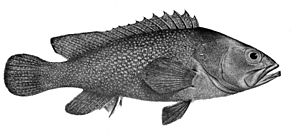Pseudorhabdosynochus summanae facts for kids
Quick facts for kids Pseudorhabdosynochus summanae |
|
|---|---|
| Scientific classification | |
| Genus: |
Pseudorhabdosynochus
|
| Species: |
summanae
|
Pseudorhabdosynochus summanae is a tiny species of flatworm that lives as a parasite on the gills of a fish called the grouper, specifically Epinephelus summana. This worm is a type of monogenean, which means it spends its entire life on one host. It was first described in 1969, from only four samples, and was originally named Diplectanum summanae. Later, in 1986, scientists moved it to a different group of worms called Pseudorhabdosynochus.
What is Pseudorhabdosynochus summanae?
Pseudorhabdosynochus summanae is a very small worm, only about 0.3 to 0.5 millimeters long. That's less than half a millimeter! It has a flat body, similar to other worms in its group. At the back of its body, it has a special organ called a haptor. This haptor is like a strong suction cup that the worm uses to hold onto the gills of its host fish.
How does it attach to its host?
The haptor, which helps the worm attach, has two special parts called squamodiscs. One squamodisc is on the top (dorsal) side, and the other is on the bottom (ventral) side. These discs help the worm grip tightly to the fish's gills, making sure it doesn't get washed away by the water.
Where does Pseudorhabdosynochus summanae live?
This tiny worm was first found near Heron Island, which is off the coast of Queensland, Australia. It lives on the gills of the grouper fish known as Epinephelus summana. This particular type of grouper is its only known host.


